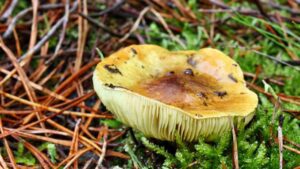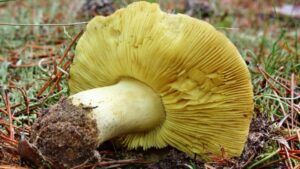Know in one minute about Tricholoma equestre
|
Note: This article is for informational purposes only. We do not recommend eating this mushroom without conducting thorough research and consulting a qualified expert.
Introduction
Tricholoma equestre is a fungus belonging to Basidiomycota. Widely distributed in Northern Scotland, southern Britain, and Ireland. Commonly grown as ectomycorrhizal with pine trees, and sandy areas.
Sometimes also seen in birches and with oaks. It occurs alone and in scattered form. Considered an edible mushroom but some cases of mushroom poisoning are also seen. It has notched gills and medium stature. Partial veil (ring)l is absent (1). This mushroom is considered the most controversial mushroom because there are many cases reported in many countries related to Tricholoma equestre poisoning. In Poland, this mushroom is considered edible, but in France, its distribution and consumption are illegal as it is banned (3).
Classification
| Kingdom | Fungi |
| Division | Basidiomycota |
| Class | Agaricomycetes |
| Order | Agaricales |
| Family | Tricholomataceae |
| Genus | Tricholoma |
| Species | T. equestre |
Common name
Man on horseback
Yellow knight
Saddle–shaped Tricholoma
Synonyms
Agaricus equestre L.,
Agaraicus auratus paulet
Agaraicus flavovirens Pers
Tricholoma equestre var. equestre ( L.) P. Kumm
Tricholoma auratum (Paulet) Gillet
Tricholoma flavovirens ( Pers) S. Lundell.
The appearance of Tricholoma equestre
Cap

Bright greenish–yellow when young, but turns brown in the center at maturity. The width of this mushroom is about 5-10 cm. Caps are covered with a skin layer, which is sticky when fresh and can be peeled off. Convex in shape with a wavy margin. White or pale yellow flesh (1).
Stem
About 5–7 cm long and 1.5–2.5 cm thick with an enlarged base. Pale yellow in color with a brownish base. Rings are absent. Basal mycelium is white.
Gills

The gills are short with pale-yellow in color, mostly attached with a notch (adnexed).
Spore of Tricholoma equestre
White, smooth, and ellipsoidal with hilar appendages.
Spore print
Spore prints are white.
Odor
No distinctive odor
Note– Tricholoma equestre looks similar to the Tricholoma sulphureum, a mushroom that has strong coal gas.
Bioactive compounds
The fruiting bodies contain many bioactive compounds such as phenolic compounds like ferulic, syringic, p-coumaric, caffeic, vanillic acid, etc. Besides this, it also contains three different types of sterols (2).
Compounds present in Tricholoma equestre
The fruiting body of this mushroom contains the following macronutrients and microelements per 100 gm of dry matter
| calcium | 43 mg / 100 gm |
| magnesium | 28.6 mg / 100 gm |
| copper | 4.9 mg / 100 gm |
| iron | 98 mg / 100 gm |
| zinc | 17 mg / 100 gm |
Medicinal properties
This mushroom contains unsaturated fatty acids such as palmitic acid, oleic acid, and linoleic acid, these fatty acids are essential for the normal body functioning of humans, therefore Tricholoma equestre is considered a good source of unsaturated fatty acid. But avoid its excessive consumption (2).
Ergosterol which is isolated from the extract of this mushroom may act as an antioxidant, antimicrobial, and antitumor activity. In addition to this, it may also show pharmacological activities like reducing inflammatory pain, and cardiovascular diseases and inhibiting the activity of the cyclooxygenase enzyme (2).
Health benefits of Tricholoma equestre
1. Anti-cancer activity
The fruiting bodies of this mushroom contain flavomannin- 6,6’ dimethyl ether that shows anti-cancer activity. This compound inhibits the cell division and proliferation of CaCo-2 colorectal cancer (4). Colorectal cancer is the development of cancer from the colon or rectum of the large intestine.
2. Lowers heart diseases
This mushroom is one of the good sources of unsaturated fatty acid, which may reduce the chances of many heart-related diseases (cardiovascular diseases) such as hypertension and atherosclerosis (5).
The unsaturated fatty acids play an important role in stabilizing heart rhythms, and lower blood pressure, therefore reducing the risk of cardiovascular diseases.
3. Effect on hypercholesterolemia
The extract of this mushroom contains oleic acid in abundance. this oleic acid is highly effective in counteracting hypercholesterolemia (5).
Hypercholesterolemia is a condition of high cholesterol level in the blood, oleic acid helps to reduce the concentration of LDL low–density lipoprotein cholesterol in the human body and increases the level of HDL high-density lipoprotein cholesterol, thus oleic acid neutralizes the effect of hypercholesterolemia.
4. Antimicrobial activity
The cyclohexan extract of this mushroom shows high antimicrobial activity against E.coli Klebsiella pneumoniae (Causes pneumonia), Staphylococcus aureus (causes various infection in the human body such as bone infection, joints infection, bloodstream infection, abscesses, cellulitis) and Enterococcus faecalis (responsible for wound infection and urinary tract infection) (2).
5. Anti-inflammatory activity
Sterols present in these mushrooms are highly effective against inflammation. Inflammatory activity for cyclooxygenase 1 and 2 (COX 1 and COX2), which produce the prostaglandins that are responsible for pain and cause infection (mainly COX 2). Ergosta – 4, 6, 8 (14), 22 – tetraen- 3 one also used as a therapeutic agent (6, 7 & 8).
Side effects of Tricholoma equestre
1. Avoid excessive consumption
Excessive consumption or consuming this mushroom without consulting qualified experts can cause many health-related problems.
2. Rhabdomyolysis
The fruiting bodies of this mushroom cause rhabdomyolysis, which means it causes the rapid decomposition of transverse striated muscle tissue. Which may sometimes lead to death. From the years 1992–2016, several cases of mushroom poisoning have been recorded in several European countries like France and Germany.
3. Fatal poisoning
Repeated consumption (triple meal of 100–400 g of fresh fruiting bodies of mushroom) may lead to fatal poisoning. The first 12 cases of fatal poisoning were recorded in France (1992–2001) It shows symptoms of weakness, pain in muscles, sweating, and dark urine in patients. Therefore, the excess consumption of Tricholoma equestre is harmful and causes many health problems (9,10, 11, 12 & 13).
Written By: Neetu Ladiya
